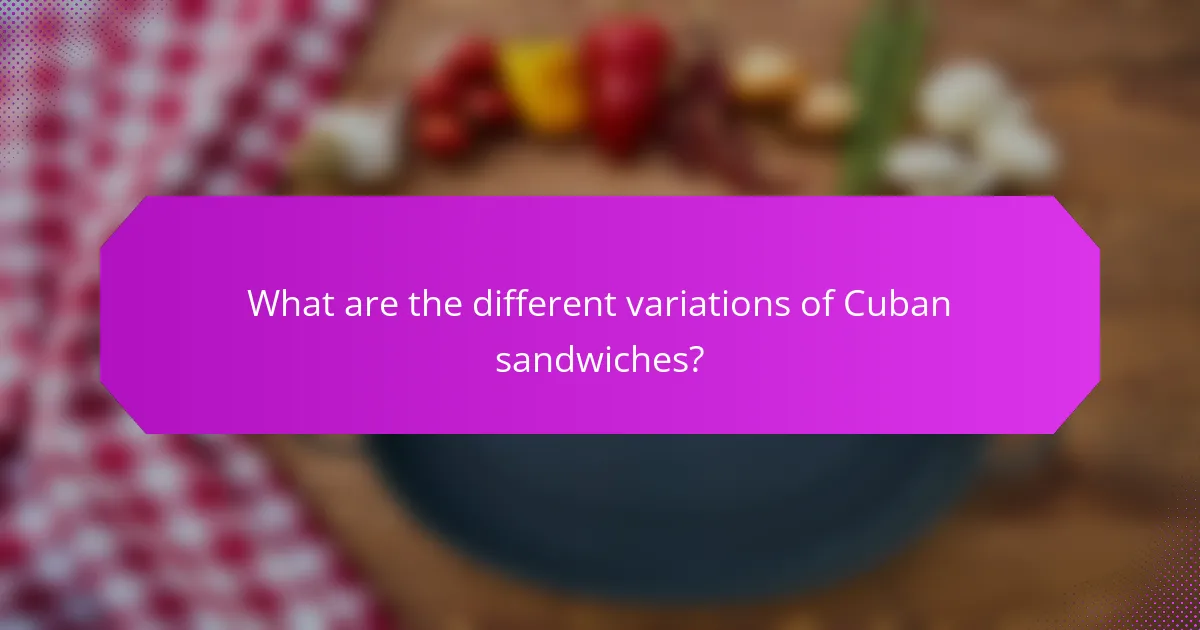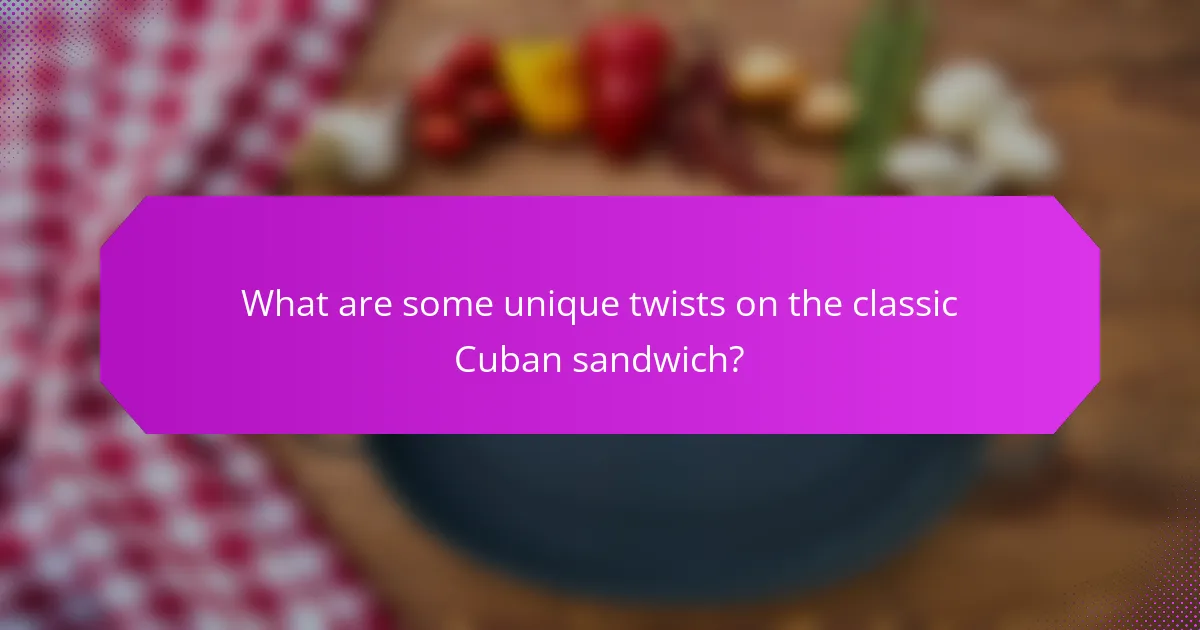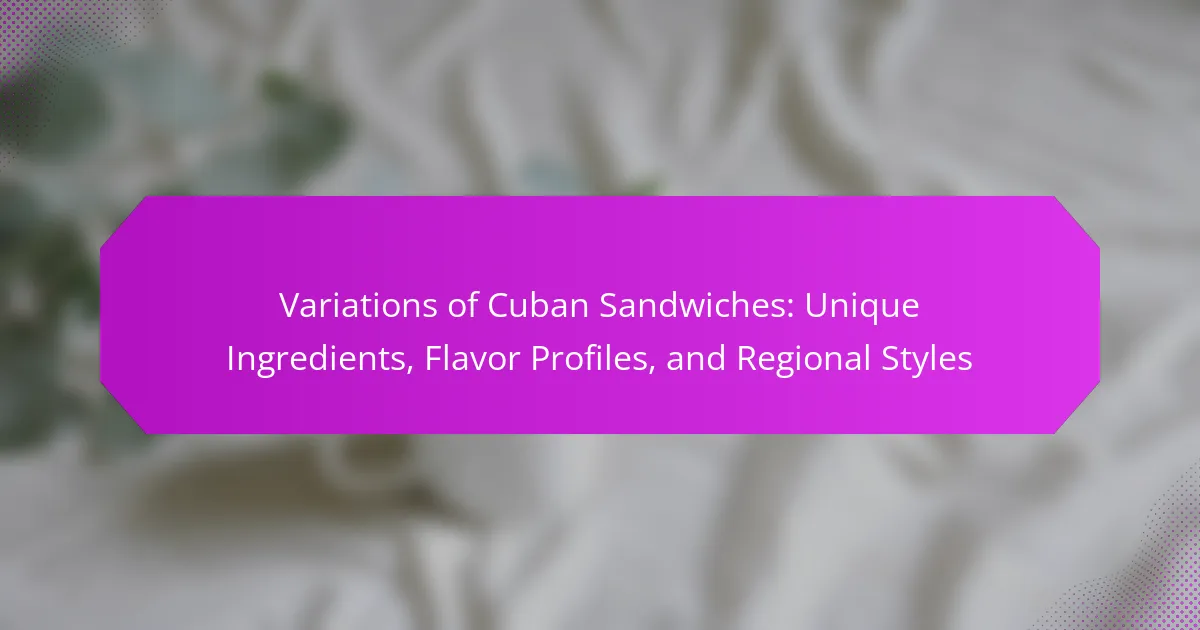Cuban sandwiches are a popular culinary item with various regional adaptations and ingredient variations. The classic version includes roast pork, ham, Swiss cheese, pickles, and mustard on Cuban bread, while alternatives like the “Medianoche” and “Cubanito” introduce sweet bread and salami, respectively. Other modifications involve substituting proteins such as turkey or chicken and experimenting with different cheeses and toppings. This article explores the diverse flavor profiles and preparation styles of Cuban sandwiches, highlighting the importance of high-quality ingredients and offering tips for an enhanced dining experience.

What are the different variations of Cuban sandwiches?
Cuban sandwiches have several variations that reflect regional preferences and ingredient availability. The classic Cuban sandwich features roast pork, ham, Swiss cheese, pickles, and mustard on Cuban bread. Variations include the “Medianoche,” which uses sweet bread instead of Cuban bread. Another variation is the “Cubanito,” which adds salami to the traditional ingredients. In some regions, the “Cuban sandwich” may be made with turkey or chicken as a substitute for pork. The “Cuban sandwich” can also vary in preparation style, such as being pressed or grilled. Each variation offers a unique flavor profile while maintaining the core elements of the sandwich.
How do unique ingredients shape the variations of Cuban sandwiches?
Unique ingredients significantly shape the variations of Cuban sandwiches. Different regions in Cuba and the Cuban diaspora incorporate local flavors and available ingredients. For example, traditional Cuban sandwiches include roasted pork, ham, Swiss cheese, pickles, and mustard. In Miami, variations might add salami due to local influences.
In Tampa, a notable variation includes Genoa salami, reflecting Italian heritage. The choice of bread also affects the sandwich’s texture and flavor. Cuban bread is standard, but other types may be used in different regions.
These unique ingredients contribute to diverse flavor profiles and culinary experiences. Each variation tells a story of cultural influences and regional preferences.
What are the essential ingredients in a traditional Cuban sandwich?
The essential ingredients in a traditional Cuban sandwich include Cuban bread, roasted pork, ham, Swiss cheese, pickles, and mustard. Cuban bread is a key component, providing a soft yet crispy texture. Roasted pork, often marinated in citrus and spices, adds rich flavor. Ham contributes a savory element, while Swiss cheese melts beautifully. Pickles provide a tangy contrast. Mustard enhances the overall taste, tying the ingredients together. This combination creates a distinctive flavor profile that is characteristic of Cuban cuisine.
What unique ingredients can be found in regional Cuban sandwiches?
Regional Cuban sandwiches feature unique ingredients such as lechón asado, which is slow-roasted marinated pork. This ingredient is particularly popular in Cuban cuisine and adds a distinct flavor. Another unique ingredient is the use of pickles, which provide a tangy contrast to the richness of the meats. Swiss cheese is a common component, known for its melting quality and mild flavor. Additionally, some regions incorporate mustard for an extra kick. In Miami, for instance, Cuban sandwiches often include salami, reflecting the city’s diverse cultural influences. These variations showcase the adaptability of the Cuban sandwich across different locales.
What flavor profiles are associated with Cuban sandwiches?
Cuban sandwiches feature a savory and tangy flavor profile. The combination of roasted pork, ham, Swiss cheese, pickles, and mustard creates a rich taste. The pork is marinated in citrus and garlic, adding brightness. The pickles contribute a sharp, acidic note. The mustard enhances the overall tanginess. The bread, typically Cuban or bolillo, adds a subtle sweetness. Together, these ingredients create a balanced and satisfying flavor experience.
How do spices and seasonings enhance the flavor of Cuban sandwiches?
Spices and seasonings enhance the flavor of Cuban sandwiches by adding depth and complexity. Common spices include garlic, cumin, and oregano. These spices contribute aromatic qualities that elevate the overall taste. Seasonings like black pepper and salt balance the richness of meats. The use of mustard adds a tangy contrast to the savory elements. Additionally, the marination of pork with citrus juices infuses a zesty brightness. Each spice and seasoning plays a role in creating a harmonious flavor profile. This combination results in a well-rounded and satisfying culinary experience.
What role do the cooking methods play in the flavor profiles of Cuban sandwiches?
Cooking methods significantly influence the flavor profiles of Cuban sandwiches. The traditional method involves pressing the sandwich on a grill, which creates a crispy exterior. This grilling process caramelizes the bread and enhances its flavor. Additionally, the heat from grilling melds the flavors of the ingredients, such as roasted pork, ham, and cheese. The use of butter or oil during grilling adds richness and depth to the taste.
Different cooking techniques can also alter the texture. For example, frying the sandwich can result in a different crunch compared to grilling. The choice of cooking method impacts the overall sensory experience of the sandwich. Ultimately, the method used directly affects flavor, texture, and aroma, making it a crucial factor in the enjoyment of Cuban sandwiches.
What are the regional styles of Cuban sandwiches?
Cuban sandwiches exhibit several regional styles across Cuba and the United States. The traditional Cuban sandwich from Cuba primarily includes roasted pork, ham, Swiss cheese, pickles, and mustard on Cuban bread. In Miami, the Cuban sandwich is often made with additional ingredients like salami, reflecting the city’s diverse cultural influences. Tampa’s version includes Genoa salami and is known for its distinct flavor profile. In Key West, the sandwich may incorporate local seafood, showcasing regional culinary traditions. Each style emphasizes unique ingredients and preparation methods that reflect local tastes and cultural influences.
How do Cuban sandwiches differ across various regions in Cuba?
Cuban sandwiches differ across various regions in Cuba primarily in their ingredients and preparation methods. In Havana, the traditional Cuban sandwich features roast pork, ham, Swiss cheese, pickles, and mustard on Cuban bread. In contrast, the Santiago de Cuba variant often includes a spicier blend of meats and a different type of bread, reflecting local tastes. The central region of Cuba may use additional ingredients like salami, which is less common in other areas. Regional preferences for bread texture and crust also vary, with some areas favoring a softer bread while others prefer a crustier loaf. Additionally, the method of pressing the sandwich can differ, impacting the overall flavor and texture. These variations illustrate the diverse culinary landscape across Cuba, shaped by local ingredients and cultural influences.
What influences local culture and history have on regional Cuban sandwich styles?
Local culture and history significantly influence regional Cuban sandwich styles. Cuban sandwiches vary by region due to local ingredients and culinary traditions. For example, Tampa’s Cuban sandwich incorporates Genoa salami, reflecting the Italian immigrant influence. In contrast, Miami’s version typically features a more traditional combination of roast pork, ham, and Swiss cheese. Historical trade routes and agricultural practices also shape ingredient availability. Regions with a strong agricultural presence may include fresh produce or local cheeses. The cultural melting pot of Miami introduces diverse flavors and fusion elements. Each regional style tells a story of its community’s heritage and preferences. Thus, local culture and history create distinct Cuban sandwich variations across the country.
How do variations of Cuban sandwiches connect to cultural traditions?
Variations of Cuban sandwiches reflect cultural traditions through their diverse ingredients and preparation methods. Each region in Cuba incorporates local flavors and influences into the sandwich. For example, the use of roast pork is common, symbolizing the significance of the pig in Cuban culinary culture. In Miami, variations often include additional ingredients like salami, reflecting the city’s immigrant influences. The preparation methods also vary, with some regions emphasizing grilling techniques that highlight communal cooking practices. These sandwiches serve as a culinary representation of Cuban identity and heritage. They connect generations through shared recipes and family traditions, reinforcing cultural bonds.
What are the most popular types of Cuban sandwiches found today?
The most popular types of Cuban sandwiches today include the Classic Cuban, the Medianoche, and the Cubano. The Classic Cuban features roasted pork, ham, Swiss cheese, pickles, and mustard on Cuban bread. It is known for its balance of flavors and textures. The Medianoche is similar but uses sweet bread and is typically served at night. It contains the same ingredients as the Classic Cuban but offers a different taste experience due to the bread’s sweetness. The Cubano is a broader term that may refer to variations in different regions, often including additional ingredients like salami or different types of cheese. Each type reflects the cultural influences and regional preferences found within Cuban cuisine.

What are some unique twists on the classic Cuban sandwich?
Unique twists on the classic Cuban sandwich include the use of different proteins, cheeses, and spreads. One variation substitutes pulled pork for traditional roasted pork. Another twist features turkey instead of ham, appealing to those seeking a lighter option. Some recipes incorporate Swiss cheese alternatives, such as pepper jack, for added spice. Additionally, avocado can replace pickles, offering a creamier texture. A regional variation includes the addition of fried plantains, enhancing the sandwich’s flavor profile. These adaptations reflect personal tastes and regional influences on the classic Cuban sandwich.
How are modern interpretations of Cuban sandwiches being created?
Modern interpretations of Cuban sandwiches are being created through innovative ingredient combinations and diverse culinary influences. Chefs are experimenting with various proteins, such as pulled pork, roasted vegetables, and even plant-based alternatives. They are also incorporating unique spreads, like garlic aioli or chipotle mayo, to enhance flavor profiles.
Additionally, bread options are diversifying beyond traditional Cuban bread. Some interpretations use ciabatta or sourdough for varied textures. Regional styles are influencing these creations, with different areas adding local ingredients and flavors. For example, Miami versions may include tropical fruits, while New York adaptations might feature deli meats.
Overall, modern Cuban sandwiches reflect a blend of tradition and contemporary culinary trends. This evolution showcases the adaptability of the sandwich to cater to diverse tastes and dietary preferences.
What fusion ingredients are commonly used in contemporary Cuban sandwiches?
Contemporary Cuban sandwiches often include fusion ingredients such as avocado, jalapeños, and chipotle mayo. These ingredients enhance the traditional flavors of the sandwich. Avocado adds creaminess and richness. Jalapeños introduce a spicy kick. Chipotle mayo offers a smoky, zesty flavor profile. Other variations may incorporate elements like roasted pork belly or different types of cheese. These adaptations reflect a blend of culinary influences. The use of fusion ingredients showcases the evolving nature of Cuban cuisine.
How do chefs experiment with traditional recipes in their variations?
Chefs experiment with traditional recipes by altering ingredients, techniques, and presentation. They may substitute meats or add unique toppings to create new flavor profiles. Regional variations often influence these changes, reflecting local tastes and available ingredients. For instance, a Cuban sandwich may incorporate different types of bread or sauces. Chefs also experiment with cooking methods, such as grilling or steaming, to enhance textures. Some chefs draw inspiration from cultural influences, merging traditional recipes with global cuisines. This experimentation allows for innovation while respecting the essence of the original dish. Such practices keep culinary traditions alive and evolving.
What are some common misconceptions about Cuban sandwiches?
One common misconception about Cuban sandwiches is that they always contain mayonnaise. In reality, traditional Cuban sandwiches do not include mayonnaise. They typically consist of Cuban bread, roasted pork, ham, Swiss cheese, pickles, and mustard. Another misconception is that all Cuban sandwiches are the same across regions. Variations exist, with some regions adding ingredients like salami or using different types of bread. Additionally, many believe that Cuban sandwiches are exclusively a Cuban dish. However, they have been influenced by other cultures, especially in areas with large immigrant populations. Understanding these misconceptions helps clarify what a Cuban sandwich truly represents.
Why is the Cuban sandwich often confused with other sandwich types?
The Cuban sandwich is often confused with other sandwich types due to its similar ingredients and preparation methods. Many sandwiches feature layers of meat, cheese, and bread, making them appear alike. The Cuban sandwich specifically includes Cuban bread, roast pork, ham, Swiss cheese, pickles, and mustard. Variations of these ingredients exist in other sandwiches, such as the Miami-style sandwich or the medianoche. Additionally, the grilling technique used for Cuban sandwiches resembles that of pressed sandwiches found in various cultures. This overlap in components and cooking methods leads to confusion among consumers. The Cuban sandwich’s unique identity can be obscured by these similarities.
What are the myths surrounding the origins of the Cuban sandwich?
The origins of the Cuban sandwich are surrounded by several myths. One myth claims it was created in Cuba, but many believe it originated in Florida. Another myth suggests that the sandwich was exclusively made for Cuban workers in cigar factories. In reality, it gained popularity among various demographics. Some also believe that the original Cuban sandwich contained mayonnaise, but traditional recipes do not include this ingredient. Additionally, there is a misconception that the sandwich must always include pickles, while variations exist without them. Historical evidence shows that the Cuban sandwich evolved over time, influenced by different cultures and tastes.

What tips can enhance your experience with Cuban sandwiches?
To enhance your experience with Cuban sandwiches, focus on using high-quality ingredients. Freshly baked Cuban bread is essential for the best texture and flavor. Opt for marinated pork, as it adds depth and authenticity to the sandwich. Layer the sandwich with Swiss cheese, pickles, and mustard for a classic taste. Press the sandwich on a hot grill to achieve a crispy exterior and warm interior. Pair the sandwich with a side of plantain chips for a complementary crunch. Enjoy with a refreshing beverage like a Cuban coffee or a mojito to balance the flavors. These tips will elevate your overall enjoyment of Cuban sandwiches.
How can you best prepare and serve a Cuban sandwich at home?
To best prepare and serve a Cuban sandwich at home, start with key ingredients: Cuban bread, roasted pork, ham, Swiss cheese, pickles, and mustard. Slice the Cuban bread lengthwise. Layer roasted pork, ham, Swiss cheese, and pickles inside the bread. Spread mustard on both sides of the bread for added flavor. Preheat a panini press or skillet. Grill the sandwich until the bread is crispy and the cheese is melted, usually about 3-5 minutes. Serve the sandwich hot, cut diagonally for easy eating. The Cuban sandwich originated in Cuba and is a popular dish in Cuban-American communities, showcasing a blend of flavors and textures.
What are the key steps to assembling a perfect Cuban sandwich?
To assemble a perfect Cuban sandwich, start with fresh Cuban bread. Slice the bread lengthwise without cutting all the way through. Layer the sandwich with mustard on both sides. Add slices of roasted pork as the main protein. Place ham slices on top of the pork. Include Swiss cheese for flavor and meltability. Add dill pickles for tanginess. Close the sandwich and press it in a sandwich press or grill. Cook until the bread is crispy and the cheese is melted.
What side dishes pair well with Cuban sandwiches?
Fried plantains pair well with Cuban sandwiches. They provide a sweet and savory contrast. Another excellent choice is black beans and rice. This dish adds protein and complements the sandwich’s flavors. A side of yuca fries offers a crispy texture. Coleslaw is also popular, adding crunch and tanginess. These sides enhance the overall dining experience.
The main entity of the article is Cuban sandwiches, which feature various regional variations influenced by local ingredients and cultural traditions. The article explores the classic Cuban sandwich and its adaptations, such as the Medianoche and Cubanito, highlighting essential ingredients like roasted pork, ham, Swiss cheese, pickles, and mustard. It discusses how unique ingredients and cooking methods shape the flavor profiles of these sandwiches, as well as the impact of regional styles across Cuba and the Cuban diaspora. Additionally, the article addresses misconceptions about Cuban sandwiches and offers tips for enhancing the culinary experience.
